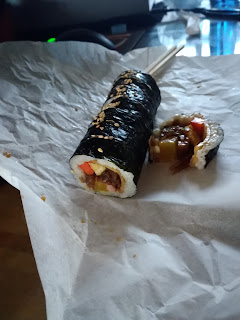Hey, thanks for visiting! I've actually moved this blog post to my new site, so please go check it out there!
↓
A Log of Things - Gimbap Varieties
As
you may know, kimchi is the
life-blood of Korea. It’s eaten at almost every meal; breakfast, lunch, or
dinner, it doesn’t matter. Koreans live and die by kimchi. But, there’s a second, equally important type of food
that is too often overlooked: the delicious, discounted delicacy that is gimbap.
Gimbap is Korea's version of sushi, whether they'll admit it or not. In its most basic form, gimbap is an assortment of vegetables (carrots, burdock roots, radishes, etc.), meats (spam, imitation crab, tuna), and other ingredients (egg and cheese) wrapped in sticky rice, wrapped in roasted seaweed. Specialty gimbap can include kimchi and various meats, spices, and sauces. It’s delicious, nutritious(?), and extraordinarily affordable at any convenience store or restaurant. A full sized gimbap is enough for a filling lunch and costs, at maximum, $2.00.
Gimbap is Korea's version of sushi, whether they'll admit it or not. In its most basic form, gimbap is an assortment of vegetables (carrots, burdock roots, radishes, etc.), meats (spam, imitation crab, tuna), and other ingredients (egg and cheese) wrapped in sticky rice, wrapped in roasted seaweed. Specialty gimbap can include kimchi and various meats, spices, and sauces. It’s delicious, nutritious(?), and extraordinarily affordable at any convenience store or restaurant. A full sized gimbap is enough for a filling lunch and costs, at maximum, $2.00.
I’d
say I eat gimbap four, maybe five times a week. At this point, I consider myself an expert on the dish, a connoisseur,
if you will. The smells, the tastes, the performance of the different wooden
chopsticks, I know it all. To pass on some of this vast knowledge, I’ve taken
it upon myself to review a variety of gimbap
flavors and styles. This short review series is not complete and certainly not comprehensive. To fully understand the intricacies of convenience store gimbap takes time and focus. Still, take this as an opportunity to learn about an exotic culture's cuisine.
First,
a few definitions
- Bulgogi: Marinated beef strips
- Chamchi: Tuna
- Kimchi: Salted and fermented vegetables, usually cabbage. Staple of Korean cuisine.
- Konbini: Convivence stores
- Tonkatsu: Fried pork cutlet
- 7-11: Same as the 7-11 in the U.S. of A. My personal favorite chain of konbinis because they’re cheap, clean, and the guy working at the one down the street is always nice to me.
- CVS for U: Widely known as just CU, this is CVS’ foray into the Korean convenience store market. They are newer and have a unique selection of gimbap.
- GS25: The third konbini of the “big three” chains. I’d consider GS to be the ugly stepchild of konbinis.
Tonkatsu
Gimbap (CU)
- Has a sweet, flavorful sauce akin to the Big Mac
sauce at McDonalds. Vegetables play second-fiddle
to the pork
- Tonkatsu adds a much-needed texture, great for mouth feel
- 2500 Won (~$2.00) is on the expensive side, but it’s probably worth the premium cost
Verdict:
A solid 7/10
Chamchi Gimbap (Gimbap Chong-guk)
- Has a different taste than the convenience store gimbaps, but that’s not necessarily to its benefit
- The vegetables are noticeably fresher
- The rice is as dry as West Texas
- No wow factor whatsoever
Verdict: 4/10
Chamchi
Gimbap from (7-11)
- As vanilla as they come but still the old standby of Korean gimbap
- Calories per won, it simply cannot be beat
- Arguably, these are flavorless hunks of rice, tuna, and seaweed
Verdict: Perfectly average, 5/10
Bulgogi Gimbap (GS25)
- GS25 gimbaps have a superior seaweed wrap
- Bulgogi, as a protein, is not the best introduction to gimbap. It’s flavor does not meld well with the vegetables.
- The rice left room to be desired. A lot of room
- I added some kimchi on top, excellent idea on my part
Verdict: Boring 4/10
With added kimchi:
7/10
Brilliance of adding kimchi: 11/10
Original Gimbap
(CU)
- Nothing is added for flavor or texture. Perfect if you love the taste of rice.
- Essentially just calories at this point
- Waste of a good gimbap opportunity
Verdict: calories/10
Spicy Pork Gimbap (CU)
- Brings the perfect amount of spiciness. It’ll leave you sweating but not yet regretting your decision to eat more gimbap.
- It’s common knowledge that pork is far superior than beef in gimbap
- Everything a konbini gimbap should be: tasty, spicy, and full of calories
Verdict: 8/10
Original Sesame (Noodle place
downstairs that is never open when you want it to be)
- Sesame adds a welcome sweetness
- As with other non-konbini gimbaps, has an undeniable fresh taste. Like eating your first strawberry after a month of only Jacked 3D Jalapeño Pepper Jack DoritosTM
- Kimchi would be an excellent addition
Verdict: 7/10
Hot pepper gimbap (CU)
- Hot pepper adds a unique, mushy consistency to gimbap
- The pepper has a good burn. The burn helps you ignore the fact that you’ve eaten gimbap for 12 days straight and your body is starting to hate you.
- Something solid or a protein would go a long way with this one
Desperation level: Tom Hanks in Cast Away
Bonus: Tonkatsu Burger (CU)
- 90% bun
- With more meat, sauce, and lettuce, it might actually be edible
- Perfect dessert after a delicious gimbap
Verdict:
4/10
Korean-ness:
10/10









No comments:
Post a Comment